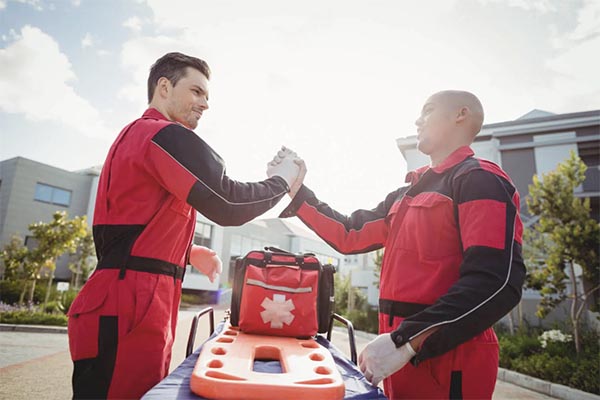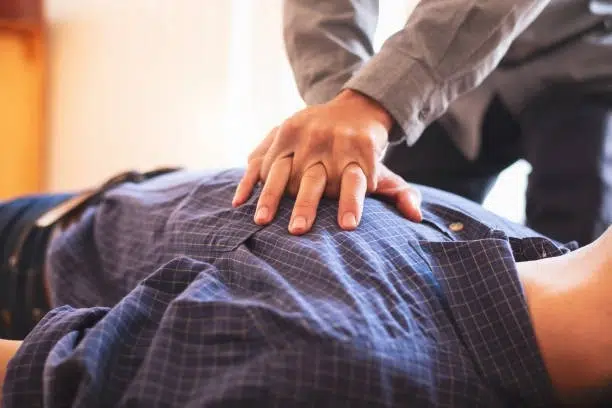
Imagine you’re at a restaurant, a family dinner, or simply sharing a meal with a friend, and suddenly, someone begins to struggle. They can’t speak, can’t breathe, and their face is turning red. This terrifying moment is a choking emergency, a silent and swift threat that can turn a normal day into a tragedy in mere seconds. The airway is a delicate pathway; when it’s blocked by food or another object, the brain is deprived of oxygen. Without immediate intervention, the consequences can be fatal.
The good news is that you don’t have to stand by helplessly. Knowing what to do can make all the difference. Simple, effective first aid techniques can dislodge the obstruction and restore breathing. This guide is designed to empower you with the knowledge to act quickly and confidently in a choking emergency. We’ll walk you through the critical steps for both adults and infants, ensuring you are prepared to be the hero when it matters most.
How Can You Tell Someone is Choking?
Recognizing the signs of a choking emergency is the crucial first step. While movies might show dramatic gasping, real-life choking can be surprisingly quiet. The person may be unable to make a sound because no air can pass through their vocal cords. It’s important to look for a combination of visual cues and physical responses.
The most universal sign is the “universal sign of choking”: hands clutched to the throat. However, not everyone will do this, so it’s essential to be aware of other indicators. A person may have difficulty breathing, or their breathing might be noisy, like a wheezing sound. They might be unable to cough, or their cough is weak and ineffective. Their skin may appear flushed or even turn blue (cyanosis) around the lips, a sign that they are not getting enough oxygen. Lastly, they might panic, looking scared and distressed, but be unable to speak or cry out for help. If you notice these signs, you need to act immediately.

What Is the First Step When Responding to a Choking Emergency?
Your first step is to stay calm and assess the situation. Panicking will only hinder your ability to think and act effectively. Immediately ask the person, “Are you choking?” If they can speak, cough, or breathe, their airway is only partially blocked. In this case, encourage them to cough forcefully on their own. Do not perform any first aid techniques like the Heimlich maneuver yet, as their own coughing is the most effective way to clear the obstruction.
If they cannot speak, cough, or breathe, it means they have a severe, complete airway obstruction. This is a true emergency. At this point, you must immediately call for professional help. If you are alone, call 911 (or your local emergency number) on speakerphone as you begin to administer first aid. If someone else is with you, designate them to call for help while you focus on the victim. Time is of the essence, and getting emergency responders en route is critical, even if you are able to dislodge the object.
How Do You Perform the Heimlich Maneuver on an Adult?
The Heimlich maneuver, also known as abdominal thrusts, is a life-saving technique for a conscious adult who is choking. The goal is to create a sudden rush of air from the lungs, forcing the obstruction out of the airway. To perform the Heimlich maneuver:
- Stand behind the person: Wrap your arms around their waist.
- Make a fist with one hand: Place it just above their navel.
- Grasp your fist with your other hand: Make sure your thumb side is against their abdomen.
- Perform rapid upward thrusts: Press into their abdomen with a quick, upward motion, as if you are trying to lift them up.
- Continue thrusts: Repeat this motion 5 times. Check if the object has been dislodged after each set of 5 thrusts.
- Alternate with back blows: Some protocols recommend alternating 5 abdominal thrusts with 5 back blows (see the next section for how to perform back blows). Continue this cycle until the object is dislodged or the person becomes unconscious.
Remember, the goal is to apply pressure to the diaphragm, not the ribs. The force should be strong enough to create the necessary pressure without causing injury.
What Should You Do If You Are Choking and Alone?
Choking while you are by yourself is a terrifying scenario, but it is not a helpless one. You can still perform a version of the Heimlich maneuver on yourself. The principle remains the same: create pressure to force the object out. Here’s how you can save yourself:
- Make a fist: Place your thumb side against your abdomen, just above your navel.
- Grab your fist: With your other hand, grab your fist.
- Perform upward thrusts: Press your fist into your abdomen with a quick, upward motion.
- Use a firm object: Alternatively, you can lean forward over a firm object, such as the back of a chair, the edge of a counter, or a railing.
- Press your upper abdomen: Lean your abdomen onto the object and quickly and forcefully thrust yourself onto the object to create the necessary pressure.
Repeat these thrusts until the object is dislodged. The force from the thrusts should mimic the action of another person performing the Heimlich maneuver on you.
What Are the Key Differences When Responding to a Choking Child or Infant?
Responding to a choking child or infant requires different techniques to account for their smaller and more delicate bodies. You must never perform abdominal thrusts (the Heimlich maneuver) on an infant under one year of age, as it can cause serious internal injuries.
- For a Child (1 to 8 years old): You can perform the Heimlich maneuver, but with less force. Kneel down to their level and use less powerful thrusts. You can also alternate between 5 back blows and 5 abdominal thrusts.
- For an Infant (under 1 year old):
- Support their head and neck: Lay the infant face down on your forearm, supporting their head and neck with your hand. The infant’s head should be lower than their chest.
- Deliver back blows: Use the heel of your free hand to deliver 5 firm back blows between the infant’s shoulder blades.
- Turn the infant over: Flip the infant face up on your other forearm, still supporting their head.
- Perform chest thrusts: Using two fingers, deliver 5 quick chest thrusts to the center of their breastbone, just below the nipple line.
- Repeat: Continue alternating 5 back blows and 5 chest thrusts until the object is dislodged or the infant becomes unresponsive.
Always call 911 immediately for an infant choking emergency, even if they begin to breathe on their own. It’s crucial that they are medically evaluated.

What Happens If a Choking Victim Becomes Unconscious?
If, despite your best efforts, the choking victim becomes unresponsive and collapses, you must immediately transition to CPR. When a person becomes unconscious, their airway relaxes, and you may be able to see and remove the obstruction.
- Lower them to the ground: Carefully help the person to the ground, laying them flat on their back.
- Check for the object: Open their mouth and look for the object. If you can clearly see it and it is within reach, try to remove it with a finger sweep. Warning: Do not perform a blind finger sweep, as you might push the object further down. Only remove it if you can see it.
- Begin CPR: If you cannot see or remove the object, begin CPR. Start with chest compressions. The compressions can help dislodge the object. Give two rescue breaths after every 30 compressions.
- Continue CPR: Continue CPR until emergency medical services arrive and take over.
This is a critical transition that requires training. Knowing how to perform CPR is the next logical step after attempting to clear a choking obstruction.
Conclusion: Why Training is the Ultimate Preparedness
Choking emergencies are unpredictable and can happen anywhere, to anyone. While this guide provides essential information, the best way to prepare for these situations is through formal, hands-on training. A CPR certification course covers not only CPR but also detailed choking first aid for adults, children, and infants. These classes provide you with the practical skills and confidence to act decisively and correctly under pressure. You’ll learn the proper body mechanics, the correct force to apply, and how to adapt your response to different scenarios.
Don’t wait until an emergency strikes to wish you had the knowledge. Becoming certified is a simple, proactive step that can make you a true life-saver. Contact CPR Classes Near Me today to find a course and learn the skills that could one day save the life of a loved one, a friend, or even a stranger. Your preparedness is their best chance.
FAQs about Choking First Aid
Q: What is the main difference between a mild and severe choking emergency?
A: A mild choking emergency is when a person is able to cough forcefully, speak, or breathe. Their airway is only partially blocked. In this case, you should encourage them to keep coughing and watch them closely. A severe choking emergency is when the person is unable to speak, cough, or breathe, and their airway is completely blocked. This is when you must perform immediate first aid, such as the Heimlich maneuver, and call emergency services.
Q: Can I perform the Heimlich maneuver on a pregnant person or an obese person?
A: Yes, the technique is modified for these individuals. Instead of performing abdominal thrusts, you should perform chest thrusts. Stand behind the person and place your arms under their armpits. Make a fist and place it in the middle of their breastbone. Grasp your fist with your other hand and deliver quick chest thrusts. This is an effective and safer alternative.
Q: Is it safe to give an infant water to drink if they are choking?
A: No, you should never give a choking infant or child anything to drink or eat. This could worsen the situation by forcing the object further down their airway or introducing a new obstruction. The only appropriate response is to perform the correct first aid techniques to dislodge the object.
Q: When should I call 911 during a choking emergency?
A: You should call 911 immediately if the person is unable to speak, cough, or breathe. If you are alone, call on speakerphone as you begin to administer first aid. Even if you are able to dislodge the object, you should keep the line open, and the person should be medically evaluated to ensure there are no lasting injuries or complications.
Q: Will a CPR certification course teach me how to respond to a choking emergency?
A: Yes, absolutely. A comprehensive CPR certification course covers detailed instruction on responding to choking emergencies in adults, children, and infants, in addition to teaching you how to perform CPR. It is the best way to get the hands-on practice and confidence you need to act in a real-life situation.

Leave a Reply